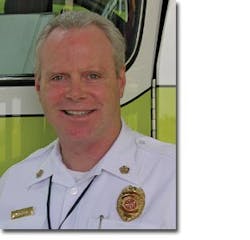Preparing for a Pandemic
When the first wave of H1N1 influenza broke last spring, Massport began the preparatory steps for reducing the spread of the flu and protecting Logan’s passengers and staff — while also minimizing the destruction to business operations. As fire chief Bob Donahue points out, “Planning for a public health threat is not new to us.” Also, ACI-NA’s Deborah McElroy speaks with AIRPORT BUSINESS about the association’s efforts to give guidance for potential outbreaks of communicable disease.
Contingencies for H1N1 are in place at Boston Logan International Airport, thanks to preparatory planning for past public health threats including the Ebola outbreak, SARS, monkeypox, and the avian influenza. Fire chief Donahue stresses a community-based approach to protecting public health by integrating the airport with the city of Boston; thinking of it as just another neighborhood. With this strategy in mind, Massport has implemented a fully integrated emergency medical and public health response system, explains Donahue.
A systematic approach
With more than 18,000 people working at the airport and moving some 80,000 passengers through the facility each day, Boston Logan generates some $8 billion to the local economy. Appropriate communication and coordination from all stakeholders, both on and off the airport, was necessary, relates Donahue.
During a potential influenza outbreak, 15 to 35 percent of the local population might become ill, and 20 percent of working adults might become ill, says Donahue. “We anticipated that our total absentee rate could be upwards of 40 percent.
“We have provided a planning template for our airlines and business partners in terms of ensuring the continuity of operations,” says Donahue.
Massport has also linked the airport with the City of Boston Medical Intelligence Center through the Boston Public Health Commission, he says, to keep a thumb on the pulse of the influenza’s status globally.
Since 9/11, Massport has been improving and harmonizing coordination between TSA, FBI, FAA, CDC (Center for Disease Control), ATC, airlines, and cargo companies, relates Donahue. “We review the previous 24 hours of operation, and we gear up for the next 24 hours; we all know what is scheduled to happen,” he explains.
With regard to public education, “We have launched the ‘Good Health and Hygiene’ campaign,” says Donahue. “We have placed posters in all restrooms with a very simple four-step message: wash hands frequently; cover mouth and nose when coughing or sneezing; limit contact with others if ill; and teach children healthy habits.
“We have also issued to all of our airport workforce, both electronically and manually, multilingual fact sheets about H1N1.”
The airport’s flu prevention messaging efforts are communicated via the public address system and the CCTV systems.
In terms of disinfecting, Massport consulted the Massachusetts General Hospital regarding its cleaning procedures and techniques for common public areas; it has built those standards into the contracts of the airport’s cleaning crews, relates Donahue. The airport has also placed hand-sanitizers throughout the terminals and work areas of the airport.
Emergency response
“We have met with the entire airport community and our public health partners and have conducted workshops on emergency response to flu-like symptoms,” comments Donahue.
“We have established a unified command that includes fire, EMS, the Public Health Commission, and CDC; that group would manage the event.
“We have also executed extensive table-top exercises regarding H1N1; it’s an all-hazard approach to emergency planning.”
On the topic of risk management, Donahue says, “Understanding what type of airport Logan is — an origin and destination airport with 85 percent of our traffic beginning and ending here — that helps you peel back the layers of the airport and have a better understanding of the intricacies of how it works.
“Planning for the H1N1 influenza came together almost seamlessly because of the partnerships that we are able to establish before events happen.”
